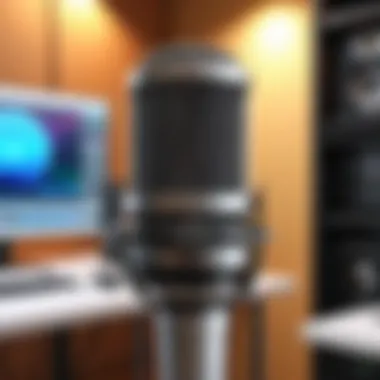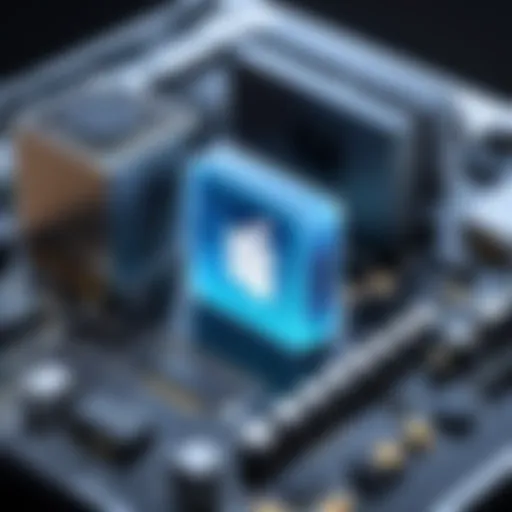Effective Strategies to Eliminate Microphone Noise


Intro
Microphone noise is a pesky issue that plagues not only amateur podcasters and streamers but also professional audio engineers. Understanding what causes this noise and how to effectively combat it can make the difference between a muddled mess and crystal-clear audio. In today’s world, where high-quality communication is essential—be it for gaming, video conferences, or music production—knowing how to minimize unwanted sounds becomes crucial.
This piece aims to unravel the various methods available to tackle microphone noise, spotlighting practical techniques and smarter choices for both hardware and software. Each step will help enhance your recording quality, ensuring that every word resonates beautifully, without any distracting background hums or crackles.
So, whether you’re setting up for a Twitch stream or recording a voiceover for that podcast series, this guide is here to arm you with the know-how to up your sound game.
Understanding Microphone Noise
In the world of audio recording and communication, microphone noise can be the proverbial fly in the ointment. Understanding this noise, its types, and how it affects sound quality is essential for anyone aiming for clear and professional audio. Microphone noise not only impacts the listener's experience but can also influence the effectiveness of the message being conveyed. By grasping the nuances of microphone noise, one can make informed choices when selecting equipment, adjusting settings, or employing noise reduction techniques.
The significance of understanding microphone noise is manifold. Firstly, it aids in troubleshooting issues that may arise during recordings, thus saving time and resources. Secondly, comprehending the various types of noise can help in choosing the right equipment—better suited to environments and purposes. Finally, awareness leads to enhanced audio quality, ensuring that your voice, music, or sounds come through crisply and clearly.
Defining Microphone Noise
Microphone noise refers to any unwanted sound that is captured by a microphone, detracting from the desired signal, which could be speech or music. This noise can stem from a variety of sources, including equipment malfunctions, environmental factors, or improper handling of the microphone itself.
Types of Microphone Noise
Microphone noise can be broadly categorized into three types, each with its own character and impact:
Static Noise
Static noise is often the unwanted hissing or crackling that happens in audio recordings, resulting from electrical interference or circuit issues in the microphone. It can be especially distracting in recordings because it seems to hover around the primary audio, like an unwelcome ghost at a party. While it’s common, it’s not to be understated; minimizing this noise is crucial to achieving a clear audio output. One notable feature of static noise is its persistence. It can appear sporadically during recordings, leading to frustration. However, the right hardware solutions, like quality cables and connectors, are beneficial for mitigating this issue.
Background Noise
This noise encapsulates all sounds that reside in the atmosphere surrounding a microphone during a recording. It might include conversations in an adjacent room, the hum of an air conditioning unit, or outdoor traffic sounds. The key characteristic of background noise lies in its dynamic nature; it fluctuates based on the environment and can change without warning. Background noise is often a prevalent nuisance, especially in home studio settings or public spaces. By strategically placing microphones and using acoustic treatments, this type of noise can often be lessened, leading to superior audio quality.
Hum and Buzz
Hum and buzz are typically electrical interferences that arise from improperly grounded equipment or faulty power supplies. Hums often resonate at a low frequency, while buzz tends to be sharper and higher in pitch. Both types can breach the audio clarity that many seek in their recordings. They tend to manifest predominantly in vocal or instrumental recordings, leading to an audible distraction that can be detrimental to the listener’s focus. A central attribute of hum and buzz is their reliance on the electrical environment, which means they can often be eliminated with careful equipment arrangement and grounding practices.
Identifying the Source of Noise
Understanding where microphone noise originates is crucial for improving audio quality. When it comes to clean recordings, pinpointing the source of noise can make all the difference. Whether you're a seasoned audio engineer or a novice podcaster, realizing the factors at play enhances one's ability to mitigate unwanted sounds and refine the overall listening experience.
Several key elements can lead to microphone noise, and addressing them properly can drastically elevate the audio clarity. It goes beyond just applying noise filters or seeking the latest equipment. This section breaks down external environment factors, microphone placement and technique, and equipment issues, all of which are essential for an optimal recording setup.
External Environment Factors
Location Considerations
Selecting the right location for recording is a major factor that can affect sound quality. An ideal recording environment reduces interference from outside sources—traffic, people, or construction noise. Sound waves bounce around in open spaces, creating echoes and muddiness. A quieter, smaller room can significantly dampen these effects.
The walls can absorb sound—it's a beneficial characteristic. For example, suppose you decide to record in a closet. It might sound cramped, but the clothing acts as a natural sound absorber, significantly reducing the chances of echo and background noise. Each location has its own unique features. A studio, while expensive, allows for controlled acoustics, whereas a home office can be adapted with pillows and curtains to serve the same purpose. Both have their advantages and disadvantages, depending on budget and intent.
Ambient Sound Levels
Ambient sound refers to the background noise present in an environment when no deliberate sound is made. High ambient sound levels can overwhelm the recordings. A busy café with chatter and clinking cups is not ideal for a voiceover, while a quiet library may serve just fine.
A key characteristic of ambient sound is that it's always there, like a silent opponent in a game. It creeps into recordings without much effort. To work efficiently, one must strive to minimize these sounds. If your setup is in a high-traffic area, recording during off-hours or investing in soundproof panels can yield noticeable improvements. However, if you record at home, be aware that unexpected sounds, such as children playing or vehicles outside, can sneak in. Balancing these elements is crucial for achieving the desired clarity in recordings.
Microphone Placement and Technique
Optimal Distance


The distance between the microphone and the sound source plays a pivotal role in audio quality. If you’re too close, unwanted noises, such as breaths or pops, might intrude on the recording. Conversely, being too far can make the sound thin and disconnected.
A general rule of thumb is to maintain a distance of about six to twelve inches for spoken words. This distance allows the microphone to capture rich tonal qualities while filtering out ambient noise. On the flip side, different microphones have varying pickup patterns. A cardioid microphone is designed to eliminate noise from the sides and rear, making it a popular choice for interviews or podcasts. However, moving past the optimal distance can create clear sound but also introduce background noise, potentially ruining the recording.
Angle and Orientation
The way a microphone is angled can alter its performance dramatically. Proper orientation towards the sound source can maximize clarity while minimizing distractions. For instance, tilting a microphone slightly can help in reducing plosives—unpleasant bursts of air often produced by hard consonants.
Another valuable aspect here is the uniqueness of the microphone’s design. For example, some microphones are directional, meaning they capture sound more effectively from the front while reducing what’s heard from the rear. Choosing the right angle can enhance your recordings significantly, especially in noisy environments. Ignoring these subtleties can mean the difference between a compelling audio project and an audio headache.
Equipment and Connectivity Issues
Type of Microphone
Different types of microphones cater to various recording needs. Condenser mics are generally favored for vocals due to their sensitivity and frequency range, while dynamic mics are preferred for loud sound sources, like drums.
Understanding the nuances of microphone types is key. Using a condenser mic in a noisy environment without adequate treatment might result in poor audio quality, while a dynamic microphone in a controlled space could provide crystal-clear recordings. Each has its distinct features, and mismatching can lead to undesirable outcomes that are hard to correct in post-production.
Cables and Connectors
The quality of cables and connectors should never be underestimated; they form the backbone of your audio system. Poor quality or damaged cables can introduce hum or crackling sounds that ruin recordings. High-quality XLR cables can provide a strong, clear signal, which ensures the microphone's voice travels smoothly to the audio interface.
Moreover, the type of connectors matters too. For example, XLR connectors are known for their durability and secure connection. Cheap or loose connectors can lead to intermittent connections, affecting sound quality considerably. The emphasis on this detail may seem mundane, but it can mean the world of a difference in capturing clean audio.
Techniques for Reducing Microphone Noise
Reducing microphone noise is a pivotal aspect of audio recording and communication. If you’ve ever listened back to a recording and cringed at the unwanted sounds lurking in the background, you know the struggles faced by both professional and amateur audio enthusiasts. Whether you're recording a podcast, streaming a game, or trying to have a conference call, clear sound is non-negotiable. In this section, we'll discuss practical strategies and techniques that can significantly diminish annoying noise, focusing on both hardware and software solutions.
Using Hardware Solutions
Microphone Shields and Pop Filters
Microphone shields and pop filters are tools designed to improve sound quality by minimizing undesirable noises. They are particularly effective at reducing plosive sounds, which occur when rapid bursts of air hit the microphone during speech or singing. A pop filter usually consists of a mesh material stretched across a frame, positioned in front of the mic. This simple barrier allows the desired audio to pass through while dampening harsh consonants.
Key characteristics of these tools include their affordability and ease of use. You can find pop filters at most music gear stores, and they don't require much setup.
The unique feature of a pop filter is its design, which allows for effective sound diffusion while maintaining audio clarity. However, one disadvantage is that it may require some adjustment to ensure it's well-placed and doesn’t obstruct the speaker’s voice.
Using Acoustic Treatment
Acoustic treatment involves modifying the environment where recording takes place to lessen unwanted sound reflections and reverberations. This strategy is crucial especially in spaces that amplify noise, such as rooms with bare walls and hard surfaces. By adding sound-absorbing materials like foam panels or carpets, one can significantly improve audio quality.
This method is popular because it not only reduces microphone noise but also enhances the overall recording environment. Acoustic treatment is a long-term investment that pays off in better sound quality. However, it requires some initial planning and might be less effective in places where space is limited or the layout isn’t conducive to treatment.
Software Noise Reduction Techniques
Audio Editing Software
Audio editing software plays a massive role in cleaning up noise after the recording process. Tools like Audacity or Adobe Audition offer features that easily remove background noise and enhance audio signals. They allow users to select specific audio ranges and apply various filters, contributing to a cleaner sound.
With advanced functionalities like spectral analysis, these tools empower users to pinpoint and eliminate interference. One key advantage is the variety of options available for both amateurs and professionals, catering to different budgets and needs. On the downside, mastering these tools can require some time and may be overwhelming for newcomers.
Noise Gate Plugins
Noise gate plugins are useful for eliminating sounds that fall below a specified threshold. When background noise is quieter than the intended audio, the gate effectively silences the unwanted noise, making for a cleaner recording. This technique is particularly effective for situations where certain parts of the audio can be quiet, like during pauses in speech.
The distinct feature of noise gate plugins is their ability to allow vocal nuances while still rejecting bothersome sounds. They’re a popular choice among sound engineers, but if not configured properly, they might cut off the softer parts of the voice, leading to an unnatural sound.
EQ and Filtering
Equalization (EQ) and filtering techniques further allow the user to shape their audio by boosting or cutting specific frequencies. By adjusting the EQ, you can remove certain frequency ranges that contribute to the noise. For instance, cutting out very low frequencies can help eliminate unwanted rumble that many microphones pick up.


An advantage of this method is its precision; users can customize audio to suit their preferences. However, applying EQ incorrectly might adversely affect the overall audio quality, making it sound unnatural or hollow if key frequencies are over-filtered.
Combining Methods for Maximum Effect
There's an undeniable truth in the audio world: combining different methods often yields the best results. Utilizing both hardware solutions and software techniques can create a robust noise reduction system. For example, using a pop filter to minimize plosive sounds while simultaneously applying EQ adjustments in post-production offers a comprehensive approach to achieving crystal clear audio. By integrating these strategies, you can effectively tackle various noise sources, leading to a more professional sound quality that meets your specific recording needs.
Best Practices for Microphone Usage
When it comes to achieving superior audio quality, understanding and adhering to best practices in microphone usage is paramount. The way you handle, position, and maintain your microphone can significantly influence the clarity of your recordings or live sound. Emphasizing these practices not only helps in minimizing unwanted noise but also extends the longevity of your equipment. Familiarizing yourself with the nuanced techniques and regular checks can make a world of difference in your audio output.
Testing Your Setup
Testing your setup is indispensable before diving into any recording or live application. This phase ensures that everything is functioning optimally and that any potential issues can be identified early on.
Conducting Preliminary Recordings
Conducting preliminary recordings involves capturing short audio segments to evaluate how your setup performs. This practice is valuable because it allows you to gauge the overall sound quality and identify any noise problems before the actual event. One of the key characteristics of this practice is its simplicity and accessibility—anyone can do it without needing a professional sound engineer.
A unique aspect of preliminary recordings lies in their immediate feedback. For instance, after recording a few test clips, you might realize that your microphone is picking up more ambient sound than anticipated. This awareness leads to prompt adjustments in both microphone placement and acoustical treatment. The advantage of this approach is clear: it helps nip issues in the bud, saving you from potential headaches later on. Conversely, some may consider this an extra step; however, it often proves its worth during critical moments when clarity is essential.
Analyzing Sound Quality
Analyzing sound quality is foundational in ensuring that the audio output meets professional standards. By examining the nuances of recorded audio, you can tell whether any unwanted frequencies or background noise have crept in. The big win here is being able to make informed decisions based on what you hear. This practice is beneficial because the clearer your audio is, the better your communication will be—whether in a podcast, conference, or recording project.
The unique trait of analyzing sound quality is its reliance on focused listening and critical evaluation. You might listen multiple times, shifting your attention to various elements like bass response, high-frequency clarity, and mid-range presence. While it demands a bit of patience and a keen ear, the rewards are immense: improved recording fidelity and a more professional sound.
Regular Maintenance and Checks
Maintaining your equipment and conducting regular checks can greatly limit noise problems and technical faults. This proactive approach can save time and effort in the long run.
Cleaning Equipment
Cleaning equipment isn’t just about looking good; it's vital for performance. Dust, moisture, and other particles can interfere with microphone functioning and lead to undesirable audio distortions. Regularly cleaning your microphones ensures they remain in tip-top shape, allowing for a consistent sound quality. A notable aspect of cleaning is that it can easily be incorporated into your routine without requiring much effort.
One unique feature of cleaning is the use of appropriate tools and substances. For example, using a specific cleaning brush or cloth made for electronics can prevent damage while ensuring thorough cleaning. The advantage here is clear: well-maintained gear translates to clearer sound. On the flip side, neglecting this simple task can lead to deterioration, drastically affecting sound quality over time.
Checking Connections
Checking connections is another critical component of microphone usage. Loose cables or faulty connectors can introduce noise that disrupts the audio feed. This practice allows you to identify issues before they escalate—an essential step that keeps everything running smoothly. The key characteristic of checking connections is its straightforwardness; simply touching base with all connecting parts helps catch problems early.
A unique aspect of this task is the application of good quality connectors. High-quality connectors serve not only to minimize wear but also enhance signal integrity. While some might consider it an overlooked chore, ensuring that everything is securely connected eliminates many common audio problems and paves the way for clearer sound.
"A stitch in time saves nine." Regular checks save you from larger issues lurking in the shadows.
Adopting these best practices for microphone usage, focusing on testing setups and maintaining equipment, lays a foundation for impeccable audio quality. By committing to these strategies, you will not only optimize your sound recordings but also establish a reliable workflow that enhances your audio production adventures.
Advanced Noise Management Techniques
In the realm of audio production and live sound, dealing with microphone noise is a pivotal challenge. Advanced noise management techniques go beyond basic soundproofing or using a pop filter; they dive into the technology and methodologies that can significantly enhance audio clarity. These strategies are essential for anyone serious about achieving professional sound quality.
The digital age brings with it a plethora of tools designed for audio refinement. Understanding these tools and how to employ them effectively is what separates a hobbyist from an expert. The focus here lies on two main avenues: the power of digital signal processing and machine learning techniques.
Using Digital Signal Processing
Noise Suppression Algorithms
Noise suppression algorithms are sophisticated computer programs crafted to identify and diminish unwanted sounds in an audio signal. One of the defining features of these algorithms is their ability to differentiate between desirable audio and background noise. This characteristic makes them a common choice for audio professionals looking to clean up recordings without sacrificing sound quality. A key advantage lies in their adaptability; they can be tuned to different environments and requirements, from studio conditions to live settings.


While these algorithms excel in many scenarios, they come with caveats. For instance, they might introduce artifacts or unnatural sounds when overcorrected, leading to a degrading audio experience rather than improvement. Hence, careful calibration is required to strike a balance between noise reduction and audio integrity.
Adaptive Filtering Techniques
Adaptive filtering techniques offer a dynamic approach to noise management. They allow the system to learn from incoming audio signals, adjusting in real-time to optimize performance. The standout feature is their responsiveness; they adapt based on the audio feed, making real-time adjustments to mitigate noise effectively.
This methodology is particularly beneficial in environments where noise levels fluctuate significantly, such as during live events or varied settings. However, it requires continuous processing power, which can demand considerable computational resources. Thus, choosing this path often involves trade-offs in processing speed against audio quality.
Employing Machine Learning Approaches
Analyzing Audio Patterns
The rise of machine learning in audio technology has opened new frontiers in noise reduction. Analyzing audio patterns is one such application. This technique uses algorithms designed to recognize specific sounds, enabling them to systematically reduce noise by categorizing and filtering it. A key strength is its potential to understand context; the algorithms can be trained to recognize a voice among common environmental noises, thus focusing on enhancing clarity.
However, this process isn't without its challenges. It requires vast amounts of data for training, meaning that initial implementation can be labor-intensive. Besides, if not properly trained, the system may misidentify noise, leading to unintended audio degradation.
Real-Time Adjustments
Real-time adjustments are at the forefront of audio management, relying on instantaneous data to alter sound input continuously. This technique is invaluable for sound engineers needing to adjust their settings mid-performance. The immediacy of this approach is its essential charm; it ensures that any unexpected changes in audio conditions can be met with swift corrections, preserving the overall sound quality.
One drawback, however, appears in scenarios where resources are limited, as constant adjustments can tax the system, potentially detracting from the primary focus of sound clarity. Balancing system capabilities with performance goals is crucial.
"Mastering these advanced techniques can profoundly impact the clarity and professionalism of your audio projects."
Future Trends in Noise Reduction Technology
Emerging Hardware Innovations
Cutting-edge hardware advancements are paving the way for enhanced audio experiences. Innovative microphones equipped with noise-cancelling features, for instance, are becoming more commonplace. These devices are now designed to focus on the source sound while effectively diminishing unwanted noise from the environment. Some noteworthy innovations include:
- Directional Microphones: Tailored to pick up sound from a specific direction, thereby minimizing ambient noise.
- Wireless Microphone Systems: Employing advanced transmission technologies to alleviate signal interference that typically introduces noise.
- Active Noise-Canceling Microphones: Functioning similarly to noise-canceling headphones, they analyze incoming sound waves and generate counteracting waves, reducing ambient noise significantly.
The benefits of these hardware solutions are vast. Not only do they improve sound quality, but they also enhance user experience by making recording less cumbersome. However, considerations such as cost and compatibility with existing systems must also be evaluated. Higher-end models can be pricey, and not all devices may work seamlessly with older equipment.
Advancements in Software Solutions
On the software side, exciting developments are in store. Noise reduction algorithms are becoming more sophisticated, leveraging machine learning and artificial intelligence to analyze audio patterns effectively. Here are some noteworthy software trends:
- Intelligent Noise Reduction Tools: Programs that adaptively process audio in real-time to filter out noise while preserving vocal clarity.
- User-Friendly Interfaces: New software solutions are emphasizing ease of use, allowing individuals with minimal technical skills to implement advanced noise reduction techniques.
- Collaboration with Hardware: Many software solutions are now designed to synergize with hardware, allowing for smoother workflows and more cohesive audio control.
One particular example that stands out in the realm of software advancements is the utilization of AI-driven noise suppression, which learns from user interactions to elevate sound quality progressively. This not only makes recordings sound professional but also saves hours of post-production work for many creators.
With these ongoing advancements in hardware and software, the landscape of noise reduction technology is on the brink of transformation. As tech enthusiasts, gamers, and IT professionals gear up to adopt these innovations, they can expect to record or communicate with unprecedented clarity. The balance between functionality, quality, and user experience will ultimately determine which products rise above the rest.
"In a world where audio clarity is essential, leveraging the latest noise reduction technologies is no longer optional, but a necessity."
Understanding these future trends is critical for anyone looking to invest in or improve their audio recording frameworks. The potential of emerging technologies is massive, and staying abreast of these changes can give early adopters a competitive edge in their respective fields.
Closure
Bringing together the various elements discussed in this article on microphone noise, it becomes evident how critical understanding and addressing this issue is for anyone engaged in audio work. Whether you're a podcaster, musician, or even in the gaming realm, the clarity of your audio can make or break the experience. The importance of sound quality cannot be overstated; excellent audio can captivate your audience, while poor audio will likely cause them to disengage and fumble through frustration.
Recap of Key Points
Throughout our journey, we have explored several essential strategies:
- Understanding Microphone Noise: Defining it and identifying common types, like static and background noise.
- Identifying Noise Sources: Recognizing factors such as location, placement, and the equipment you use.
- Reducing Noise: Utilizing both hardware like pop filters and acoustic treatments, and software solutions like noise gates and EQ adjustments.
- Best Practices: Advocating for regular setup testing, maintenance, and troubleshooting measures to keep your audio crisp.
- Advanced Management Techniques: Delving into digital signal processing and machine learning as cutting-edge solutions.
- Future Trends: Setting sights on exciting innovations in hardware and software that hold promise for even better noise management.
By considering these aspects, you arm yourself with valuable knowledge and practical skills to improve your audio clarity, which ultimately enhances your communication and engagement with the audience.
Final Thoughts on Achieving Clarity
As we wrap things up, achieving clarity in your recordings is not just a matter of employing the right tools—it's about mastering their use and understanding your environment. Factors like room acoustics, microphone positioning, and equipment quality play a significant role in how clean your audio comes out. Don't overlook the impact of regular checks and maintenance of your hardware, as even the slightest wear can lead to unwanted noise.
Stay adaptable; as your setup evolves, so too should your approaches to noise management. Experimenting with various techniques and a willingness to learn from each recording experience will go a long way. Remember, clear audio does not arrive by chance. It's the culmination of preparation, practice, and a keen eye on future advancements in technology. With that mindset, you'll find yourself well-equipped to face any noise-related challenge that comes your way.







